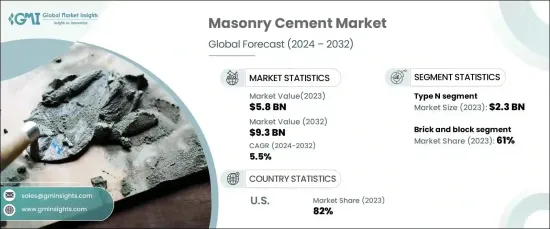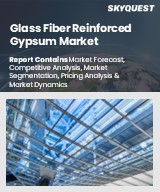
|
시장보고서
상품코드
1664864
석공용 시멘트 시장 기회, 성장 촉진요인, 산업 동향 분석 및 예측(2024-2032년)Masonry Cement Market Opportunity, Growth Drivers, Industry Trend Analysis, and Forecast 2024 - 2032 |
||||||
세계의 석공용 시멘트 시장은 2023년에 58억 달러의 평가액에 이르렀으며, 2024년부터 2032년까지 연평균 복합 성장률(CAGR) 5.5%를 나타낼 것으로 예측됩니다.
이 흥미로운 성장 궤도는 급속한 도시화와 세계 인프라 개발의 급증으로 고품질 건축자재 수요 증가에 기여하고 있습니다.

시장은 유형 S, 유형 N, 유형 M, 유형 O의 석공 시멘트로 구분됩니다. 그 중에서도 N형 시멘트가 선도하고 2023년에는 23억 달러를 창출했습니다. 2024년부터 2032년의 CAGR은 5.7%로 견조한 성장이 예측되고 있습니다. 다목적 및 적응성으로 알려진 유형 N 시멘트는 벽, 굴뚝, 일반적인 석공 용도와 같은 주택 건설 프로젝트에서 널리 사용됩니다. 신흥국 시장을 중심으로 도시 개척이 가속화되는 가운데, 저렴한 주택에 대한 요구는 계속 증가하고 있으며, 유형 N 시멘트 수요를 뒷받침하고 있습니다. 벽돌 쌓기 및 모르타르 수리와 같은 표준 건설 작업에서의 유용성으로 인해 N 형 시멘트는 건설 업계에 필수적인 툴킷이 되었습니다.
| 시장 범위 | |
|---|---|
| 시작 연도 | 2023년 |
| 예측 연도 | 2024-2032년 |
| 시작 금액 | 58억 달러 |
| 예측 금액 | 93억 달러 |
| CAGR | 5.5% |
용도별로는 벽돌 및 블록 건축, 석조 건축, 미장 및 기타로 분류됩니다. 2023년에는 벽돌 블록 건축물이 압도적인 부문으로 부상하여 시장 점유율 61%를 차지했고 2032년까지의 CAGR은 5.7%을 나타낼 것으로 예측됩니다. 이 기술은 비용 효과와 내구성으로 뒷받침되며 주택, 상업 및 산업 프로젝트에서 인기있는 옵션이되었습니다. 아시아태평양, 아프리카, 라틴아메리카 등의 지역에서 도시형 주택 수요가 증가하고 있는 것이 벽돌이나 블록 건축에 있어서 석공용 시멘트 사용의 주된 촉진요인이 되고 있습니다.
미국의 석공용 시멘트 시장은 2023년에 82%의 압도적인 점유율을 차지했고, 대도시권이나 교외에 있어서의 도시 확대와 인구 증가가 그 요인이 되고 있습니다. 이 나라에서는 주택과 상업 프로젝트를 모두 포함한 건설 활동이 활발해지고 있으며, 석공용 시멘트 수요를 견인하고 있습니다. 특히 벽돌과 블록의 건설은 내구성이 높고 효율적인 건축자재에 대한 요구 증가에 대응하며,이 성장에 중요한 역할을 합니다.
목차
제1장 조사 방법과 조사 범위
- 시장 범위와 정의
- 기본 추정과 계산
- 예측 계산
- 데이터 소스
- 1차
- 2차
- 유료 소스
- 공개 소스
제2장 주요 요약
제3장 업계 인사이트
- 업계 생태계 분석
- 밸류체인에 영향을 주는 요인
- 이익률 분석
- 방해
- 향후 전망
- 제조업체
- 유통업체
- 공급자의 상황
- 이익률 분석
- 주요 뉴스·이니셔티브
- 규제 상황
- 영향요인
- 성장 촉진요인
- 건설 활동 증가
- 급속한 도시화
- 업계의 잠재적 리스크·과제
- 시장의 포화와 치열한 경쟁
- 지속가능성에 대한 우려
- 성장 촉진요인
- 성장 가능성 분석
- Porter's Five Forces 분석
- PESTEL 분석
제4장 경쟁 구도
- 서론
- 기업의 시장 점유율 분석
- 경쟁 포지셔닝 매트릭스
- 전략 전망 매트릭스
제5장 시장 추계·예측 : 유형별(2021-2032년), 10억 달러
- 주요 동향
- 유형 N
- 유형 S
- 유형 M
- 유형 O
제6장 시장 추계·예측 : 용도별(2021-2032년), 10억 달러
- 주요 동향
- 벽돌 및 블록 시공
- 석조 벽돌
- 미장
- 기타(포장 등)
제7장 시장 추계·예측 : 최종 용도별(2021-2032년), 10억 달러
- 주요 동향
- 주택용
- 상업용
- 산업용
제8장 시장 추계·예측 : 유통 채널별(2021-2032년), 10억 달러
- 주요 동향
- 직접
- 간접
제9장 시장 추계·예측 : 지역별(2021-2032년), 10억 달러
- 주요 동향
- 북미
- 미국
- 캐나다
- 유럽
- 영국
- 독일
- 프랑스
- 이탈리아
- 스페인
- 러시아
- 아시아태평양
- 중국
- 인도
- 일본
- 한국
- 호주
- 라틴아메리카
- 브라질
- 멕시코
- 중동 및 아프리카
- UAE
- 사우디아라비아
- 남아프리카
제10장 기업 프로파일
- Ambuja Cements
- Anhui Conch
- Birla
- Buzzi Unicem
- Cemex
- China National Cement Corporation
- CRH
- Dangote Cement
- Heidelberg
- Holcim
- JK Cement
- Siam Cement
- Sinoma
- Taiheiyo
- UltraTech Cement
The Global Masonry Cement Market reached a valuation of USD 5.8 billion in 2023 and is projected to grow at a CAGR of 5.5% between 2024 and 2032. This impressive growth trajectory is fueled by rapid urbanization and the increasing demand for high-quality construction materials, driven by a surge in global infrastructure development.

The market is segmented into Type S, Type N, Type M, and Type O masonry cement. Among these, Type N cement led the pack, generating USD 2.3 billion in 2023. It is projected to grow at a robust CAGR of 5.7% during 2024-2032. Renowned for its versatility and adaptability, Type N cement is widely used in residential construction projects such as walls, chimneys, and general masonry applications. As urban development accelerates-particularly in emerging markets-the need for affordable housing solutions continues to rise, bolstering demand for Type N cement. Its utility in standard construction tasks, such as bricklaying and mortar repairs, positions it as an essential component in the construction industry's toolkit.
| Market Scope | |
|---|---|
| Start Year | 2023 |
| Forecast Year | 2024-2032 |
| Start Value | $5.8 billion |
| Forecast Value | $9.3 billion |
| CAGR | 5.5% |
By application, the market is divided into brick and block construction, stone masonry, plastering, and others. In 2023, brick and block construction emerged as the dominant segment, accounting for a 61% market share, with a projected CAGR of 5.7% through 2032. This construction method is favored for its cost-effectiveness and durability, making it a popular choice across residential, commercial, and industrial projects. The growing demand for urban housing in regions such as Asia-Pacific, Africa, and Latin America is a key driver of masonry cement usage in brick and block construction.
The U.S. masonry cement market held a commanding 82% share in 2023, fueled by urban expansion and population growth in metropolitan and suburban areas. The country's rising construction activities, encompassing both residential and commercial projects, are driving the demand for masonry cement. Brick and block construction, in particular, plays a significant role in this growth, catering to the increasing need for durable and efficient building materials.
Table of Contents
Chapter 1 Methodology & Scope
- 1.1 Market scope & definitions
- 1.2 Base estimates & calculations
- 1.3 Forecast calculations.
- 1.4 Data sources
- 1.4.1 Primary
- 1.4.2 Secondary
- 1.4.2.1 Paid sources
- 1.4.2.2 Public sources
Chapter 2 Executive Summary
- 2.1 Industry synopsis, 2021-2032
Chapter 3 Industry Insights
- 3.1 Industry ecosystem analysis
- 3.1.1 Factor affecting the value chain.
- 3.1.2 Profit margin analysis.
- 3.1.3 Disruptions
- 3.1.4 Future outlook
- 3.1.5 Manufacturers
- 3.1.6 Distributors
- 3.2 Supplier landscape
- 3.3 Profit margin analysis.
- 3.4 Key news & initiatives
- 3.5 Regulatory landscape
- 3.6 Impact forces
- 3.6.1 Growth drivers
- 3.6.1.1 Increasing construction activities
- 3.6.1.2 Rapid urbanization
- 3.6.2 Industry pitfalls & challenges
- 3.6.2.1 Market saturation and intense competition
- 3.6.2.2 Sustainability concerns
- 3.6.1 Growth drivers
- 3.7 Growth potential analysis
- 3.8 Porter’s analysis
- 3.9 PESTEL analysis
Chapter 4 Competitive Landscape, 2023
- 4.1 Introduction
- 4.2 Company market share analysis
- 4.3 Competitive positioning matrix
- 4.4 Strategic outlook matrix
Chapter 5 Market Estimates & Forecast, By Type, 2021-2032 (USD Billion) (Kilo Tons)
- 5.1 Key trends
- 5.2 Type N
- 5.3 Type S
- 5.4 Type M
- 5.5 Type 0
Chapter 6 Market Estimates & Forecast, By Application, 2021-2032 (USD Billion) (Kilo Tons)
- 6.1 Key trends
- 6.2 Brick and block construction
- 6.3 Stone masonry
- 6.4 Plastering
- 6.5 Others (paving, etc.)
Chapter 7 Market Estimates & Forecast, By End Use, 2021-2032 (USD Billion) (Kilo Tons)
- 7.1 Key trends
- 7.2 Residential
- 7.3 Commercial
- 7.4 Industrial
Chapter 8 Market Estimates & Forecast, By Distribution Channel, 2021-2032 (USD Billion) (Kilo Tons)
- 8.1 Key trends
- 8.2 Direct
- 8.3 Indirect
Chapter 9 Market Estimates & Forecast, By Region, 2021-2032 (USD Billion) (Kilo Tons)
- 9.1 Key trends
- 9.2 North America
- 9.2.1 U.S.
- 9.2.2 Canada
- 9.3 Europe
- 9.3.1 UK
- 9.3.2 Germany
- 9.3.3 France
- 9.3.4 Italy
- 9.3.5 Spain
- 9.3.6 Russia
- 9.4 Asia Pacific
- 9.4.1 China
- 9.4.2 India
- 9.4.3 Japan
- 9.4.4 South Korea
- 9.4.5 Australia
- 9.5 Latin America
- 9.5.1 Brazil
- 9.5.2 Mexico
- 9.6 MEA
- 9.6.1 UAE
- 9.6.2 Saudi Arabia
- 9.6.3 South Africa
Chapter 10 Company Profiles
- 10.1 Ambuja Cements
- 10.2 Anhui Conch
- 10.3 Birla
- 10.4 Buzzi Unicem
- 10.5 Cemex
- 10.6 China National Cement Corporation
- 10.7 CRH
- 10.8 Dangote Cement
- 10.9 Heidelberg
- 10.10 Holcim
- 10.11 J.K. Cement
- 10.12 Siam Cement
- 10.13 Sinoma
- 10.14 Taiheiyo
- 10.15 UltraTech Cement



















